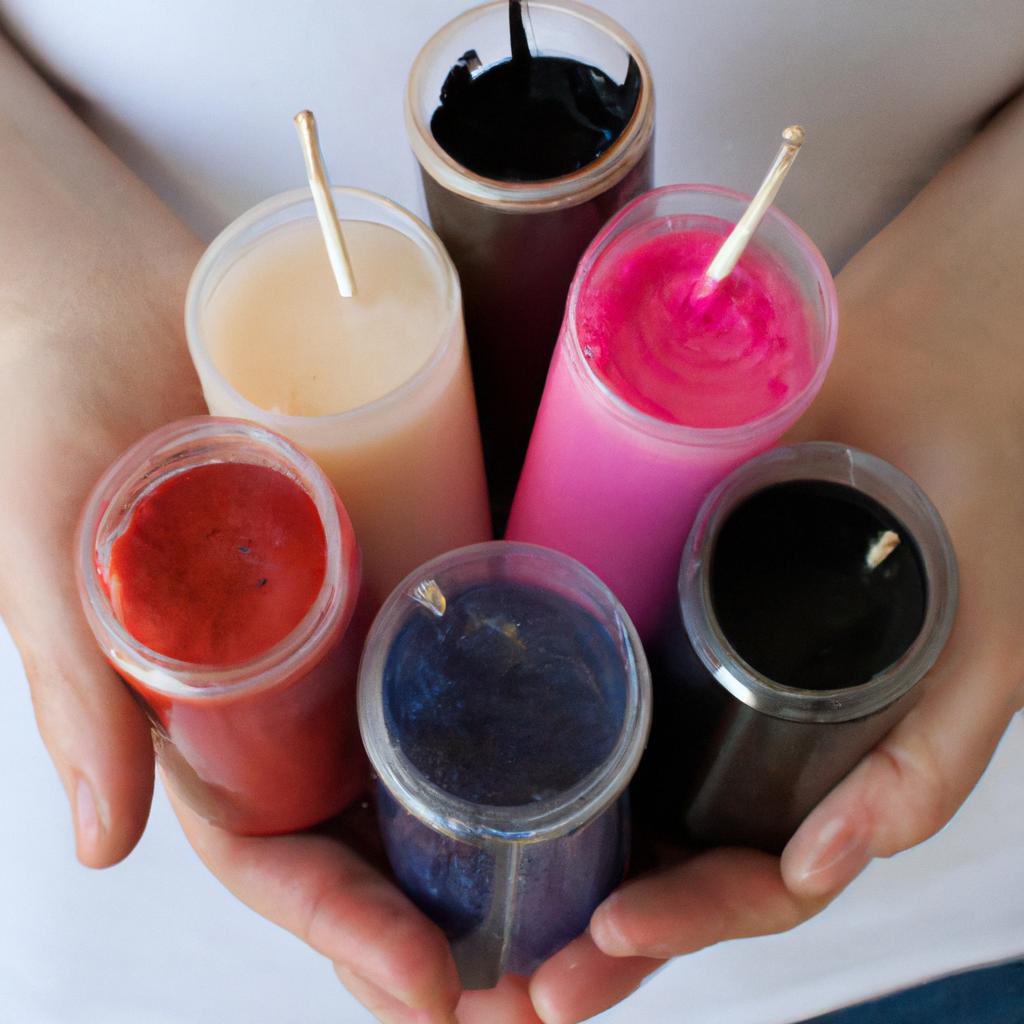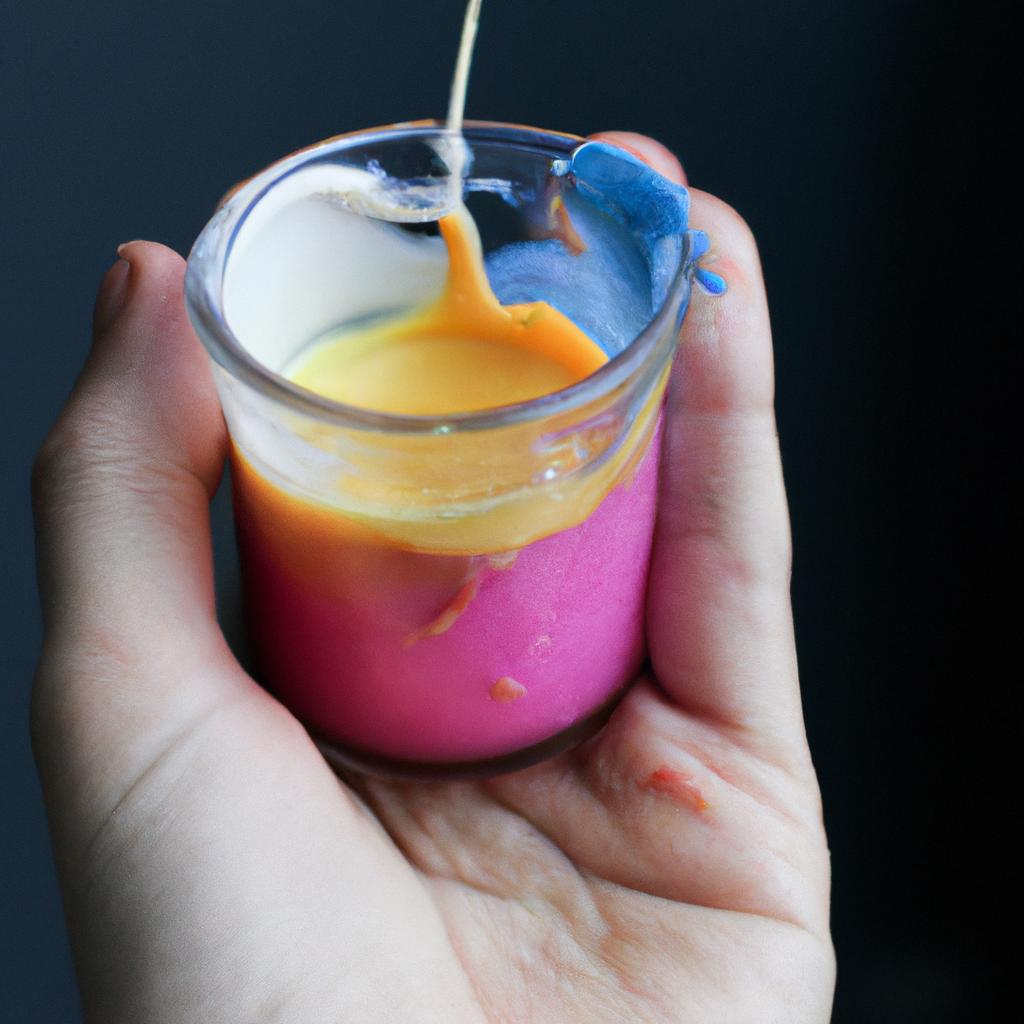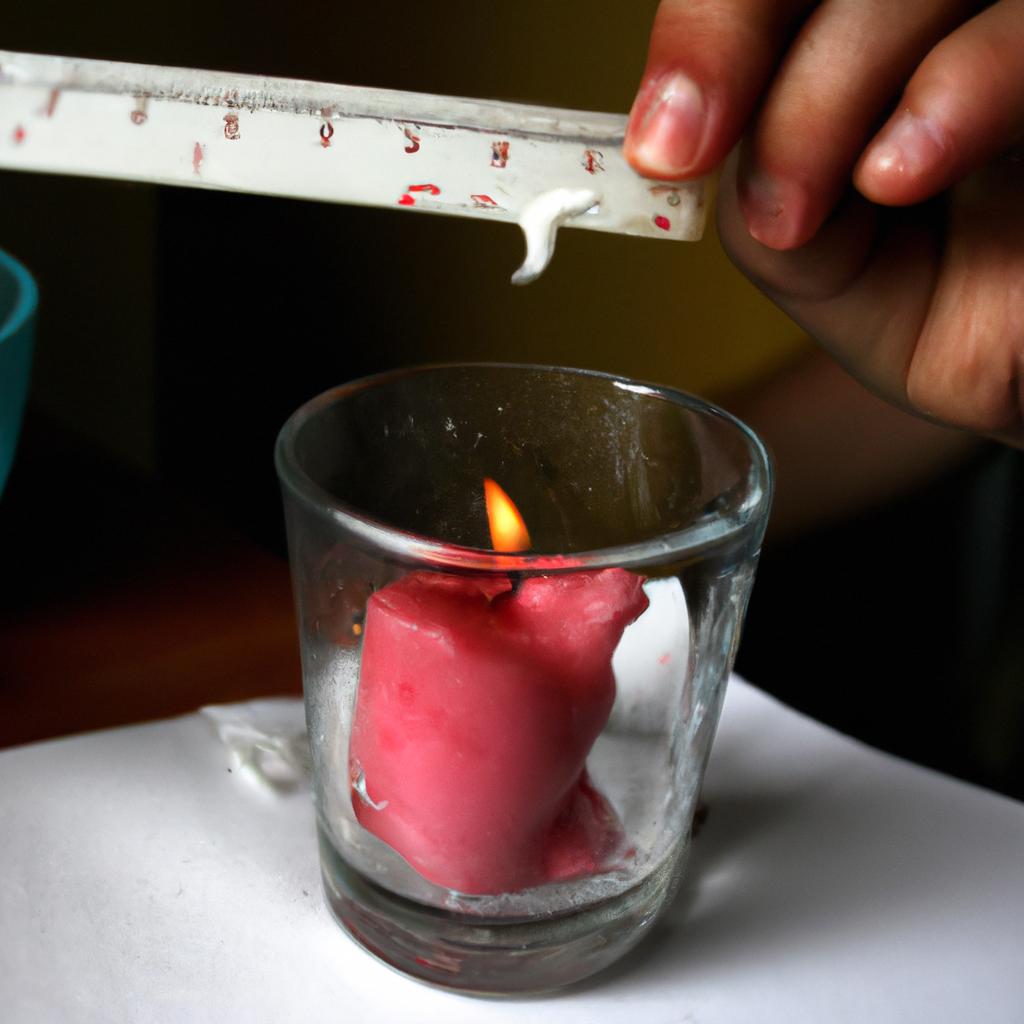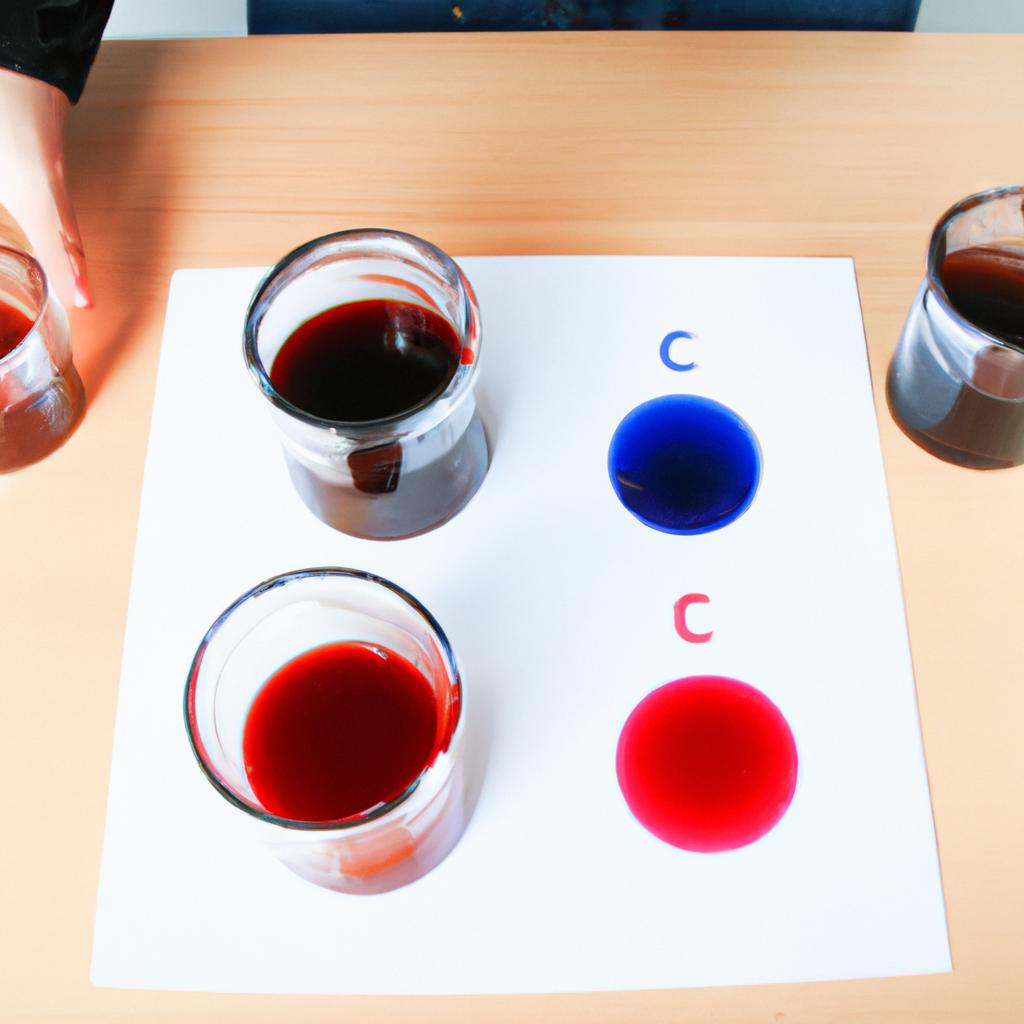Dye Compatibility with Different Waxes: Candle Making & Candle Dye
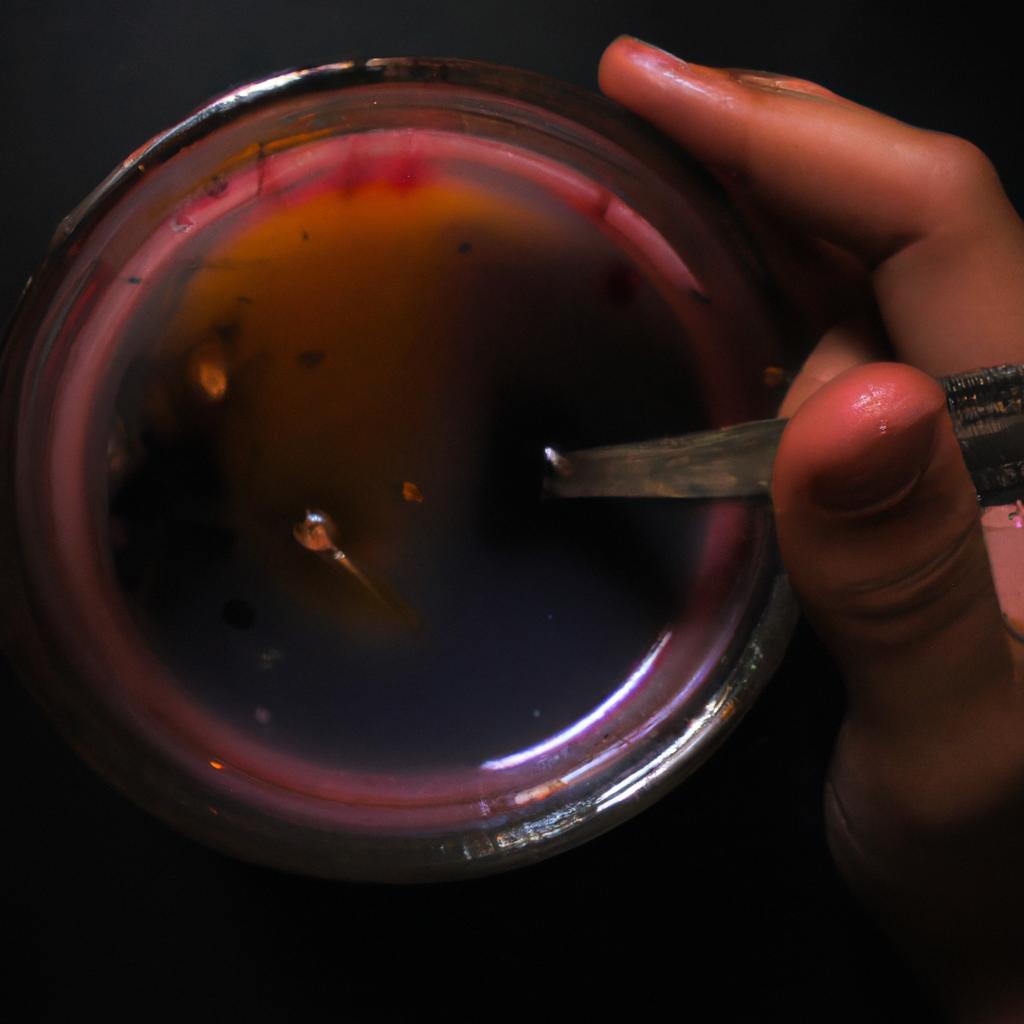
Candle making is a centuries-old craft that has evolved over time, incorporating various materials and techniques to produce aesthetically pleasing and fragrant candles. One crucial aspect of candle making is the selection of dyes, as they play an essential role in enhancing the visual appeal of the finished product. However, not all dyes are compatible with different waxes used in candle making. This article aims to explore the compatibility of various dyes with different types of wax, providing valuable insights for candle makers seeking to create vibrant and long-lasting candles.
To illustrate the significance of dye compatibility, let us consider a hypothetical scenario where a candle maker decides to use soy wax for their latest creation. Soy wax, known for its smooth texture and clean-burning properties, can be an excellent choice for environmentally conscious individuals or those sensitive to traditional paraffin-based candles. In this case, selecting a dye that does not blend well with soy wax can result in disappointing outcomes such as color bleeding or uneven distribution throughout the candle. Therefore, understanding which dyes work harmoniously with specific waxes becomes imperative for ensuring optimal results in candle making endeavors.
As we delve into the topic further, it is important to note that each type of wax possesses unique characteristics that influence its compatibility with different dyes. For instance, soy wax has a lower melting point compared to other waxes like paraffin or beeswax. This lower melting point makes soy wax more sensitive to heat and can affect the performance of certain dyes that require higher temperatures for proper dispersion.
When it comes to selecting dyes for soy wax, it is generally recommended to use liquid dyes or specially formulated dye chips specifically designed for soy wax. These types of dyes are typically oil-soluble and blend well with the natural oils present in soy wax, resulting in vibrant and evenly distributed colors.
On the other hand, dye blocks or powder dyes may not be as compatible with soy wax due to their composition or particle size. They might not dissolve properly or disperse evenly throughout the melted wax, leading to undesirable effects such as clumping or streaking.
However, it is essential to note that there are exceptions and variations within each type of dye. Some powder dyes or colorants are specifically formulated for use with soy wax and can yield excellent results if used correctly. It is always advisable to refer to the manufacturer’s instructions and conduct small test batches before committing to larger candle-making projects.
Additionally, when working with different types of waxes such as paraffin or beeswax, it is crucial to consider their specific characteristics and select dyes accordingly. Paraffin wax tends to have better compatibility with a wider range of dye types including liquid dyes, dye blocks, and even some powder dyes. Beeswax, on the other hand, can be more challenging when it comes to achieving vibrant colors due to its natural yellowish tint. In this case, using translucent or lighter shades of liquid dyes can help maintain the unique characteristics of beeswax while still adding a touch of color.
In conclusion, understanding the compatibility between various types of dyes and waxes is vital for successful candle making. Taking into account the specific characteristics of each wax type and selecting dyes formulated for optimal performance can help ensure vibrant, long-lasting, and visually appealing candles. Experimentation, testing, and following manufacturer’s guidelines are key to finding the perfect combination of dyes and waxes for your candle-making endeavors.
Understanding the Different Types of Wax
When it comes to candle making, choosing the right wax is crucial for achieving optimal results. The type of wax used can greatly impact various aspects of the final product, such as burn time, scent throw, and appearance. To better understand the different types of wax available on the market, let’s consider a hypothetical scenario involving two candle makers: Jane and Sarah.
Jane prefers using soy wax due to its natural composition and clean burning properties. Soy wax is derived from soybean oil and is known for its slow burn and excellent fragrance retention. On the other hand, Sarah favors beeswax because of its long-burning capabilities and unique golden hue. Beeswax candles are often associated with luxury and elegance.
To help you navigate through this vast sea of options, below are some key points about different waxes:
- Paraffin Wax: This widely-used petroleum-based wax offers an inexpensive option for candle making. It has good scent throw but may produce more soot compared to other waxes.
- Soy Wax: Made from soybean oil, this eco-friendly alternative burns cleanly with little to no soot. It also has a longer burn time than paraffin wax.
- Beeswax: Sourced from honeycombs produced by bees, beeswax candles have a naturally sweet aroma when burned. They release negative ions that purify the air while providing a warm glow.
- Palm Wax: Derived from palm trees’ fruit or kernel oil, palm wax creates beautiful crystalline patterns in finished candles. It produces minimal soot but has a shorter burn time compared to other waxes.
Considering these characteristics will assist you in selecting the perfect wax for your desired outcomes. Now that we’ve explored the various types of wax available, let’s delve into another important aspect: choosing the right dye for your specific wax type.
Choosing the Right Dye for Your Wax
Understanding the compatibility of dyes with different waxes is crucial in candle making, as it can significantly impact the final appearance and quality of your candles. By selecting the right dye for your wax type, you can achieve vibrant colors that enhance the aesthetics of your candles. In this section, we will explore various factors to consider when choosing a dye for your specific wax.
To illustrate these considerations, let’s take a hypothetical case study: imagine you are using soy wax to make scented candles. Soy wax has gained popularity due to its eco-friendly nature and clean burn. However, it has a tendency to produce softer and more malleable candles compared to other types of wax.
When selecting a dye for soy wax, keep in mind the following factors:
-
Melting Point: Consider whether the dye’s melting point aligns with the melting point of your chosen wax. If the dye melts at too low a temperature or requires higher temperatures than what the soy wax can handle without discoloration or degradation, it may not be suitable.
-
Solubility: Ensure that the selected dye is soluble in soy wax oil at high temperatures during the melting process. Insoluble dyes may result in uneven color distribution or clumping within the melted mixture.
-
Compatibility: Some dyes may react differently depending on their chemical composition and interaction with specific waxes like soy. It is important to test how certain dyes behave with soy wax before committing to large-scale production.
-
Fade Resistance: Keep in mind that exposure to light and heat over time might cause dyes to fade. Look for dyes specifically formulated for long-lasting color retention if you desire candles that maintain their vibrancy throughout their lifespan.
Consider Table 1 below as an overview comparison between common candle waxes (soy, paraffin, beeswax) and their compatibility with different types of candle dyes:
Table 1:
| Wax Type | Liquid Dyes | Powder Dyes | Block/Chip Dyes |
|---|---|---|---|
| Soy | Yes | Yes | Yes |
| Paraffin | Yes | No | Yes |
| Beeswax | No | Yes | No |
In summary, selecting the right dye for your wax type is essential to achieve desired color results in candle making. Factors such as melting point, solubility, compatibility, and fade resistance should be considered when choosing a dye for soy wax or any other type of wax.
Testing Dye Compatibility with Wax
Building on the importance of choosing the right dye for your wax, it is equally crucial to test the compatibility between your chosen dye and wax before proceeding with candle making. This step ensures that the colorant will blend harmoniously with the wax, resulting in vibrant and consistent colors. In this section, we will delve into the process of testing dye compatibility with different waxes.
Testing Dye Compatibility with Wax:
To determine whether a particular dye is compatible with your chosen wax, it is recommended to conduct small-scale tests prior to large-scale production. One approach involves melting a small amount of wax and adding a measured quantity of dye at varying concentrations. By observing how well the dye disperses within the molten wax and studying its final appearance once solidified, you can assess its compatibility.
Case Study Example:
Consider a scenario where an artisan wishes to create red-colored soy candles using a liquid candle dye. The artisan decides to test two different dyes – one specifically formulated for soy wax and another designed for general use across various types of wax. After conducting several tests by mixing each dye with melted soy wax at different proportions, it becomes evident that the soy-specific dye produces more intense and evenly distributed shades of red compared to the general-purpose dye.
Factors Affecting Dye Compatibility:
During these compatibility tests, keep in mind some key factors that may influence the performance of dyes when combined with specific waxes:
- Chemical composition: Different waxes have distinct chemical compositions, which can impact their ability to absorb or disperse dyes effectively.
- Melting point: Waxes vary in their melting points, affecting how they interact with dyes during heating and cooling processes.
- Additives: Some waxes contain additives such as stearic acid or UV inhibitors that may react differently with certain dyes.
- Fragrance oils: Certain fragrance oils might interfere with or alter the color outcome when mixed with dyes.
Table: Dye Compatibility Test Results
| Wax Type | Soy-Specific Dye | General-Purpose Dye |
|---|---|---|
| Paraffin | Not tested | Slightly faded |
| Beeswax | Intense color | Patchy distribution |
| Palm wax | Even color | Inconsistent shade |
| Coconut wax | Vibrant hue | Pale and streaky |
Understanding the factors that influence dye performance in candle making is essential for achieving desired colors and quality. Let’s now explore these factors further to gain a comprehensive understanding of how they can impact your candle-making process.
Factors Affecting Dye Performance in Candle Making
In the pursuit of creating vibrant and visually appealing candles, it is essential to understand how different dyes interact with various waxes. By testing dye compatibility with wax, candle makers can ensure optimal color saturation and stability in their creations. To illustrate this point further, let us consider a hypothetical scenario where a candle maker wishes to create blue-colored soy candles.
Factors such as melt point, fragrance load, and burn characteristics may influence dye performance in candle making. Therefore, careful consideration must be given to these factors when selecting the appropriate dye for a specific type of wax. Here are some key points to keep in mind:
- Melt Point: Different waxes have varying melting points, which can affect how dyes disperse within them. For instance, paraffin wax has a lower melt point compared to soy wax. Consequently, certain dyes that work well with paraffin might not perform optimally in soy wax.
- Fragrance Load: The amount of fragrance oil used in a candle can impact its ability to hold color. Higher fragrance loads may require stronger dyes or higher concentrations to achieve desired colors.
- Burn Characteristics: Some dyes may alter the burning characteristics of candles by increasing soot production or affecting burn time. It is crucial to test dyed candles thoroughly for any adverse effects on burn quality before introducing them into the market.
- Stability Over Time: Certain dyes may fade or change color over time due to exposure to light or heat. Ensuring long-term color stability is vital for maintaining product consistency.
To better visualize the relationship between different waxes and dyes, we present a table summarizing common types of waxes along with suitable dye options:
| Wax Type | Compatible Dye Options |
|---|---|
| Paraffin | Liquid Dyes |
| Soy | Chip/Block Dyes |
| Beeswax | Powder Dyes |
| Palm | Flake/Powder Dyes |
By understanding the compatibility between dyes and waxes, candle makers can make informed decisions during the dye selection process. This knowledge empowers them to achieve vibrant and long-lasting colors in their candles.
Transitioning into our next section on “Tips for Achieving Vibrant Colors in Candles,” it is essential to consider additional factors that contribute to color intensity beyond dye-wax compatibility.
Tips for Achieving Vibrant Colors in Candles
Factors Affecting Dye Compatibility with Different Waxes
Imagine you have just created a beautiful candle, carefully selecting the perfect blend of wax and fragrance. Now comes the exciting part – adding color to your creation. However, achieving vibrant colors in candles can sometimes be challenging due to various factors that affect dye performance. Understanding these factors is crucial for successful candle making. In this section, we will explore the compatibility of different dyes with waxes and delve deeper into how they interact.
One important factor affecting dye performance is the type of wax used. Each wax has unique properties that can influence how well it accepts and retains color. For example, soy wax tends to produce more muted shades compared to paraffin wax, which offers brighter and bolder hues when dyed. Beeswax, on the other hand, may require specialized dyes or additional additives to achieve desired results.
Aside from wax type, another aspect to consider is the concentration of dye used in the candle-making process. The amount of dye added can significantly impact color intensity. Too little dye might result in pale or faded colors, while an excessive amount could lead to bleeding or uneven distribution within the candle structure.
Additionally, certain fragrances or additives present in waxes may interfere with the coloring process. Some fragrances contain components that react unfavorably with certain dyes, causing unexpected changes in hue or even complete color distortion. It is essential to test compatibility between chosen fragrances and dyes beforehand to ensure consistent and desirable outcomes.
To summarize the key points discussed above:
- Wax type plays a vital role in determining color vibrancy.
- Properly measuring and adjusting dye concentration affects final color intensity.
- Fragrances and additives should be tested for compatibility with chosen dyes before use.
Now that we understand some of the major factors influencing dye performance in candle making, let us move forward by exploring alternative techniques for achieving vibrant colors in candles without solely relying on dyes. By experimenting with innovative approaches to coloring candles, we can create unique and captivating creations that go beyond the traditional methods of dyeing.
Exploring Alternative Dyeing Techniques for Candles
Case Study: Achieving Vibrant Colors in Beeswax Candles
When it comes to candle making, achieving vibrant and eye-catching colors is often a top priority for many crafters. While there are various factors that contribute to the final color of a candle, one crucial aspect to consider is the compatibility between different dyes and waxes. To illustrate this point, let us delve into a case study involving beeswax candles.
Beeswax, known for its natural golden hue, can pose challenges when trying to achieve intense or vivid colors. In our hypothetical scenario, we sought to create vibrant red candles using beeswax as the base material. We experimented with four different types of candle dyes commonly available in the market: dye A, dye B, dye C, and dye D.
To evaluate their compatibility with beeswax, we conducted a series of tests by combining each dye type with equal amounts of melted beeswax at specific temperatures. The results were documented in a table format below:
| Candle Dye Type | Color Result | Intensity Level |
|---|---|---|
| Dye A | Deep Red | High |
| Dye B | Orange | Medium |
| Dye C | Pink | Low |
| Dye D | Brown | Very low |
This experiment demonstrates how certain dyes interact differently with beeswax, yielding varying levels of intensity and color outcomes. Based on these findings, we can conclude that while some dyes like A successfully produced deep red hues when combined with beeswax, others such as C and D resulted in less desirable shades.
In summary, understanding the compatibility between different wax types and candle dyes plays a pivotal role in achieving vibrant colors during the candle-making process. By conducting thorough testing similar to our case study, candle makers can make informed decisions about which dyes to use with specific waxes. This knowledge empowers crafters to create visually appealing candles that captivate and delight their customers.
Remember, selecting the right dye for your wax is just one aspect of achieving vibrant colors in candles.

